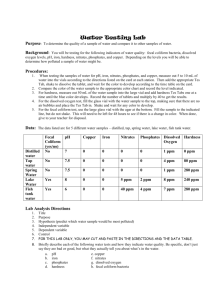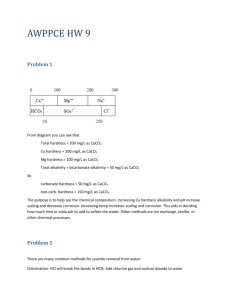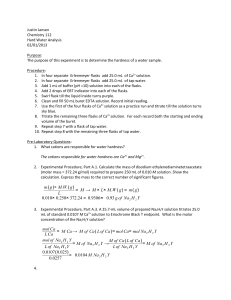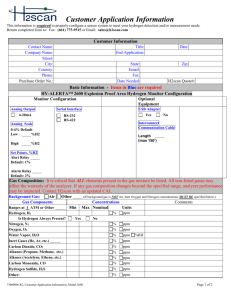The Chemistry of Natural Waters
advertisement
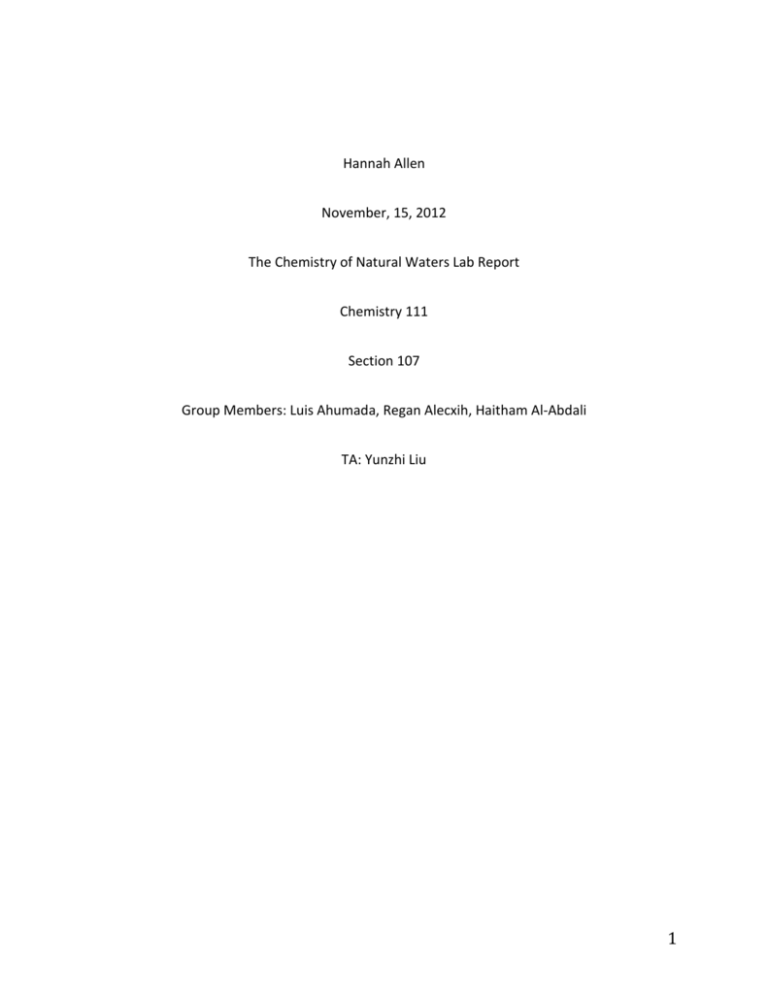
Hannah Allen November, 15, 2012 The Chemistry of Natural Waters Lab Report Chemistry 111 Section 107 Group Members: Luis Ahumada, Regan Alecxih, Haitham Al-Abdali TA: Yunzhi Liu 1 Introduction Throughout this laboratory experiment, the topic of water hardness was dealt with quite frequently. Water hardness is term used to describe the existence of Mg2+, Ca2+ and other polyvalent cations in a given sample. Water hardness, while it does not really have much of an effect on the human body save for altering taste of water, can cause other issues that merit attention. In the home and in industry, water hardness can cause irritating scale formation. Scale formation can cause harmful buildup in pipes and jets. On top of this is costly and difficult to remove.1 In the natural world water hardness causes an effect on aquatic life, specifically the fish population.2 The fact that hardness can cause problems has spurred scientists to seek testing methods. There are a few ways of measuring water hardness. EDTA titration and the utilization of Atomic Absorption Spectroscopy are probably the most common testing methods. 3 EDTA titration first starts with the adjustment of the given water sample to a pH of ten through the use of a NH3/NH4 buffer. Then, an EBT indicator will be added causing a blue color. Considering the fact that there is any Mg2+ present in the substance, the reaction will turn a wine red color. At this point, an EDTA indicator will be added. It will have a reaction with Ca 2+ first that will result in a chelate that is colorless. It will sooner or later react with Mg indicator chelate, producing a colorless MgEDTA chelate, so as the Mg2+ is removed from the indicator; it will go back to its original blue color. This reaction formula can be utilized for serial titration. In a serial titration, every titration will be ended at a different place and then the chemist will observe each step, searching for the first blue well. The first blue well indicated where there is extra EDTA because all Mg2+ has been transferred to the colorless MgEDTA chelate. From here, the 2 hardness can be calculated by finding the mass of deviant cations (since we know that the moles of deviant cations are equal to the moles of EDTA) by first using the equation: MEDTAVEDTA=MCa2+VCa2+and from here the results can be converted into whatever units are desired. 1 Atomic Absorption Spectroscopy is the second of the more common ways to test water for hardness. With this method, an atomic absorption spectrometer is used. The spectrometer is based on the fact that the metal atoms will only absorb at certain specific wavelengths.4 So, the light in the spectrometer will be set at wavelength that corresponds do either Mg2+ or Ca2+. Then the light beam will be passed through a flame connected to a sample of the water in the center of the machine. The flame will show the absorption through a change in color because the frequencies of the ions in the water are the same as that in the light beam. The beam will then be then continue through the machine, hit a mirror, be reflected to a grating and then directed through a narrow slit to be detected by the photomultiplier tube (PMT). This is where the Beer-Lambert law (It=Io(10-abc), It is the intensity of the original light) is employed to calculate the concentration of the metal because this law lets us know that the concentration of the metal in the original sample is proportional to this decrease.1 These two different methods are both utilized because they have different strengths and weaknesses that can yield different results, so when used together, the best average answer can be reached. AA Spectroscopy is useful because it eliminates many outside factors, but a downside is that it can only test one ion at a time.4 With EDTA titration, it fast and requires simpler equipment, but it can cause a problem if there is a small amount or no Mg 2+ in the sample or else no reaction whatsoever will occur.1 3 Sometimes, water is simply too hard to deal with and must be softened. There are multiple ways to soften water. Commonly, this is done through ion exchange where divalent cations are exchanged with monovalent cations. This can be done with a cation exchange resin that the water is filtered through.1 The background information taken into account, it was hypothesized that the hardest water tested in this experiment would be the tap water from State College. This is due to the fact that it was located in the central region of Pennsylvania, where the water is notoriously hard.5 Since the water fountain sample is also located in State College, if the water fountain only uses a carbon filtration system it should be almost exactly the same because this type of filtration does not affect the ions involved in hardness, rather it mainly removes chlorine.7 The Dasani water bottle will be the second to the last in hardness, with the Aquafina water bottle will be the softest considering it undergoes a reverse osmosis treatment.6 Procedure Procedure for this experiment was taken directly from PSU Chemtrek on pages 10-2-1022, there were no deviations. A few different tests were run on the same water sample. The sample was examined for total dissolved solids. To do this, a drop of the sample was placed on a piece of tin foil on a hot plate next to a drop of distilled water and a drop of 1 x 10-3 M Ca2+ for comparison. When the water was evaporated, there was a visible spot left on the foil that could be observed, the darker or more prominent the spot; it could be assumed that there were more dissolved solids in the sample. One test for hardness run was Atomic Absorption Spectroscopy. The sample was tested twice with two different spectrometers one set to detect MG 2+ and the other set to detect Ca2+. Another way the sample was tested for hardness was through EDTA 4 titration. Serial titration was used in a 1x12 well strip, and repeated twice to ensure there were no human errors in the first test. In the experiment, the water was also softened two different ways. First, the water was softened using a commercial water-conditioning agent. To do this, a sample of the water was placed in a vile with about 20 mg of the product and shaken. Then, the water was removed, titrated and compared with the titration results of the original sample. Finally, another sample of the water was placed in a vile and shaken with cation exchange resin. Then the pH of the original sample as well as the new sample was tested. Lastly, the new sample was tested for hardness with EDTA titration and compared to the original sample’s titration.1 Results Figure 1 TOTAL DISSOLVED SOLIDS TEST Sample Origin Visible Results Kitchen Tap (1926 Waddle Road State College PA)8 East Halls Water Fountain (State College, PA)9 dark white ring with a lighter center Disani Brand Bottle10 very faint white ring, clear center Aquafina Brand Bottle1 barely visible transparent white ring, clear center solid very dark white circle 5 Figure 2 DETERMANATION OF HARDNESS THROUGH EDTA TITRATION Sample Origin Molarity Hardness (ppm) Kitchen Tap (1926 Waddle Road State College PA)8 East Halls Water Fountain (State College, PA)9 Disani Brand Bottle10 Aquafina Brand Bottle11 Hardness (grains per gallon) (moles of CaCO3 per drop[volume]) 1.00x10-3 M 100 ppm 5.85 gpg 4.00x10-3 M 400 ppm 23.4 gpg 2.00x10-4 M 0M 20.0 ppm 0 ppm 1.17 gpg 0 gpg Example Calculation-Molarity MEDTAVEDTA=MsampleVsample 2x10-4M(1 drop)=Msample(1 drop) 2x10-4M=Msample This equation makes sense because it is known that the moles of divalent cations are the same as the moles of EDTA and the volume units cancel out, so the units cancel out. 1 This means that solving is straightforward and the chemist can simply solve for the variable, in this case the concentration of the sample. Example Calculation-Hardness (in ppm) 1mg/liter=1ppm (for dilute aqueous solutions) 2x10−4 CaCO3 100.0g CaCO3 1000 mg CaCO3 20 mg CaCO3 × × = = 20.0 ppm 1 liter of solution 1 mole CaCO3 1 g CaCO3 1 liter of solution In this equation, what is going on is that (due to the definition of hardness) the solute is being treated as CaCO3, thus its molar mass (100 g) is being used.1 Example Calculation-Hardness (in grains per gallon) It is known that, 1 gallon=3.785 liters So, 1 grain CaCO3 = 17.1 ppm gallon water Thus, it can be applied so that, 1 grains per gallon 200 ppm × = 1.17 gpg 17.1 ppm 6 Figure 3 Ca2+Ion Calibration Raw Data Ion Concentration (ppm) Absorbance Value 1 0.00802 5 0.03995 10 0.07397 25 0.17566 50 0.32873 Figure 4 Mg2+ Ion Calibration Raw Data Ion Concentration Absorbance Value (ppm) 0.02129 0.07682 0.13827 0.33298 0.38615 1 5 10 25 30 Figure 5 DETERMINATION OF HARDNESS THROUGH ATOMIC ABSORPTION SPECTROSCOPY Sample Origin Absorbance Value Ca2+ 0.1210 Kitchen Tap (1926 Waddle Road State College PA)8 East Halls 0.1185 Water Fountain (State College, PA)9 Disani Brand 0.0026 Bottle10 Aquafina Brand -0.0008 Bottle11 Absorbance Value Hardness from Ca2+ in ppm Hardness from Mg2+ in ppm Total Hardness Mg2+ 0.1572 40.0 ppm 47.7 ppm 87.7 ppm 0.1190 43.0 ppm 35.1 ppm 78.1 ppm 0.0522 0 ppm 13.3 ppm 13.3 ppm -0.0065 0 ppm 0 ppm 0 ppm 7 Figure 6 Sample Calculation-Hardness (ppm)- Ca2+ [using best fit line equation] y=0.0065x+0.0069 0.1210=0.0065x+0.0069 0.1141=0.0065x 17.6=x 17.6 ppm Ca2+x[ 100g CaCO3 1 mole 40.0 g CaCO3 1 mole ] = 40 ppm Figure 7 Sample Calculation-Hardness (ppm)- Mg2+ [using best fit line equation] y=0.0126x+0.0115 0.1572=0.0126x+0.0115 0.1457=0.0126x 11.6=x 11.6 ppm Mg2+x[ 100g CaCO3 1 mole 24.3 g Mg2+ 1 mole ] = 47.7 ppm Sample Calculation- Total Hardness (ppm) ppm of Mg2+ + ppm of Ca2+= total ppm 47.7 ppm + 40 ppm = 87.7 ppm In these calculations what is occurring is that the deviant cation’s ppm is being multiplied by the ratio between the molar masses of CaCO3 the deviant metal cation (either Ca2+ or Mg2+).1 8 Figure 8 SAMPLE SOFTENING WITH COMMERCIAL WATER-CONDITIONING AGENT Sample Origin Molarity after Softening Hardness after Softening (moles per volume in drops) (ppm) -3 Kitchen Tap (1926 Waddle 1.2x10 M 120 ppm 8 Road State College PA) East Halls Water Fountain 4x10-4 M 40 ppm 9 (State College, PA) Disani Brand Bottle10 1x10-4 M 10 ppm 11 Aquafina Brand Bottle 6x10-4M 60 ppm Example Calculation-Softened Sample (Molarity to ppm) 4x10−4 CaCO3 100.0g CaCO3 1000 mg CaCO3 40 mg CaCO3 × × = = 40.0 ppm 1 liter of solution 1 mole CaCO3 1 g CaCO3 1 liter of solution *explanation above Figure 9 EFFECTS OF CATION EXCHANGE RESIN Sample Origin Kitchen Tap (1926 Waddle Road State College PA)8 East Halls Water Fountain (State College, PA)9 Disani Brand Bottle10 Aquafina Brand Bottle11 Molarity Hardness (ppm) pH with resin pH without resin 6 2 2x10-4M 20 ppm 9 8 8x10-4M 80 ppm 4 6 1.67x10-5M 1.67 ppm 3 8 0.00 M 0 ppm Discussion In the total dissolved solids test, considering this experiment, the results shown were as pretty much as expected. Though the test only takes into account any and all dissolved solids in 9 the sample, it was still shown that the kitchen tap and the water fountain, both located in State College had the most dissolved solids.8,9 Considering the fact that both of these samples claim their origin in state college, technically it would be expected that they would have the same. However, since it is evident in figure 1, the sample taken from the water fountain left a darker spot. This could be due to experimental error such as inconstant drop size due to the angle the pipet was held, or difference in chemists perspective on spot severity. Another option responsible for this could be the fact that the water fountain probably utilized a carbon filter.12 Carbon filters are left defenseless against microbial contamination, sodium, fluoride, nitrates, hardness minerals, lead and other heavy metals, so it is clear that the hardness should not have lessened.13 On the contrary, when the water was filtered some of the fragments of carbon and other sediment in the filter could have left traces in the water and it is true that a total dissolved solids test can have its results effected by any chloride, nitrate, calcium, or any suspended sediment so it is reasonable to assume that these could have contributed to the data gained.14 Very much contrasting these results were the two bottled waters, the Dasani appearing to have slightly more dissolved solids than the Aquafina. 10,11 This can be explained by referencing the filtration methods of the two. Aquafina utilizes reverse osmosis which removes almost any and all particles6 while Dasani also utilizes reverse osmosis, the makers then add back minerals such as sodium chloride, potassium chloride, and magnesium sulfate 15 all of which could potentially show up in some form or another in a total dissolved solids test. It can been seen in figure 2 that through the EDTA titration test, the results were such that they showed the water fountain sample as the hardest at 400 ppm9, followed by the tap sample at 100 ppm8, Dasani bottled at 20 ppm10 and the softest being Aquafina bottled at 0 10 ppm11. As mentioned earlier, both the tap and the water fountain were both located in state college, so the relative similarities are to be expected. The harder nature of the water fountain could be contributed to the fact that EDTA titration tests for all divalent cations16 and this sample happened to contain more of these. The Dasani bottle was slightly harder than the Aquafina, and this could be contributed to the same factor considering that one of the minerals added back to Dasani is magnesium sulfate15 it can be inferred that the divalent nature of magnesium increases the hardness level beyond that of Aquafina. Figure 5 depicts the hardness values found through atomic absorbance spectroscopy. In this test, the tap water was the hardest at 87.7 ppm8, followed by the water fountain at 78.1 ppm9, Dasani at 13.3 ppm10 and finally Aquafina still at 0 ppm.11 All four of the values were significantly less than the hardness values found through EDTA titration. However, this is simple to understand with the aforementioned fact that EDTA titration’s results, unlike atomic absorption spectroscopy that only testes for Ca2+ and Mg2+ , contain all divalent cations16, naturally increasing the parts per million value. Proportionally, the only difference in hardness results was that this time the tap water was harder than that of the water fountain. This could also be due to the specificity of the test, this sample could be have more divalent cations overall, but less Mg2+ and Ca2+ than the tap water. The state college water samples should read somewhere in between 120 ppm and 190 ppm18 and both Dasani and Aquafina should have little to no hardness at all.19,20 While the values gleaned are still slightly low for these standards in the case of state college, and slightly high in the case of Dasani, it still can be assumed that this test is more accurate because the use of the instrument reduces the chance of human error and also limits the divalent cations tested to those specifically listed in the definition of water 11 hardness.1 This test is also more precise than EDTA titration because since the absorbance value is measured through instrument, rather than evaluation of the human eye, outside factors are less likely to ensue and the same results will be read each time. In figure 8 , the hardness values after the use of a commercial softener can be seen. These results in some cases were somewhat flawed. The chemist with the tap water sample and the Aquafina sample made some unknown procedural mistake (something possibly to the tune of inconstant drops, inaccurate calculations or inaccurate counting during the titration observation) that caused the sample to somehow read that it was harder than when it started 8, 11, considering the flawed nature of the results, they are extraneous and do not add to the results. The water fountain sample decreased by seventy five percent9, the Dasani by fifty percent.10 These three results do follow what should have happened. The difference in percentage softened could be due in part either to differing amounts of softener used, or they could be result of the water’s original hardness. Finally, figure 9 depicts the results of the test involving cation exchange resin. With the use of cation exchange resin, two things should happen. First, the pH should be lowered because through the ion exchange taking place, more H+ is being added1 and a higher concentration of H+ will cause a lower pH.17 Also, simply due to the fact that the divalent cations are being exchanged with monovalent cations1 the water should be softer. In the sample taken from the Dasani bottle, the pH decreased, going from a pH of 6 without the resin to a pH of 4 with it10, exhibiting the H+ additions17 and the hardness value decreased to 1.67 ppm10 because the divalent cations were exchanged with monovalent cations.1 The results of the tap water (from 2 without to 68) and the water fountain (from 8 to 99)water depicted the 12 pH rising with the use of the resin. The hardness values did lower as they should (the tap reducing to 20 ppm8 and the fountain to 80 ppm9) considering the exchange of cations. The Aquafina bottle’s pH did lower from 8 to 3 as it should have, but the hardness value increased to 10 ppm.11 These flaws deem the results not useful. Most likely, the issue occurred due to human error. A likely error would be that the chemists accidentally tainted their sample with some resin beads. The presence of such particles would definitely cause error in readings. Conclusions As expected, the both the tap and water fountain samples from state college were a toss-up for the hardest8,9 and were much harder in contrast to the very soft Aquafina11 preceded by the slightly harder Dasani.10 The total dissolved solids were tested for, both EDTA titration and Atomic Absorbtion Spectroscopy were utilized in testing the hardness of all samples, and finally cation exchange resin and commercial water conditioning agent were both used to soften the samples. Reflecting upon the background information, it can be seen that it did a fair job at holding true and aiding in the verification of hypothesis that the city water samples generally would be much harder those taken from a bottle regardless of the hardness testing method utilized. And in the end, both the natural hardness of Pennsylvania water5 contrasting the extreme softness of bottled water6 was proven true as a general rule throughout the duration of the laboratory experiments. 13 References 1. Thompson, Stephen. PSU Chemtrek; Hayden McNeil: Plymouth, 2012; pp 10-2-10-22. 2. “Understanding Water Hardness” http://www.ca.uky.edu/wkrec/Hardness.htm (accessed November 5, 2012) 3. “Determination of Water Hardness by Complexometric Titration Class Notes” http://homepages.ius.edu/DSPURLOC/c121/week13.htm (accessed November 5, 2012) 4. Christian, Gary; “Medicine, Trace Elements and Atomic Absorption Spectroscopy” Analytical Chemistry, ACS Publications: Washington, 1969, pp 17A-21A 5. “What is my Water Hardness?” http://www.qualitywatertreatment.com /city_water_guide.htm. (accessed October 15, 2012) 6. “So, What are you drinking?” http://www.myspringwater.com/ SpringWaterInformation/ LeadingWaterBrands.aspx. (accessed October 15, 2012) 7. The effects on water of reverse osmosis filtration systems. http://www.watertechonlin e.com/articles/the-effects-of-hard-water-on-reverse-osmosis-filtration-systems. (accessed October 15, 2012) 8. Al-Abdali, Haitham, Chem 111 Laboratory Notebook, pp 25-27 9. Alecxih, Regan, Chem 111 Laboratory Notebook, pp 27-29 10. Allen, Hannah, Chem 111 Laboratory Notebook, pp. 31-35 11. Ahumada, Luis, Chem 111 Laboratory Notebook, pp. 21-23 12. “Frequently asked questions about drinking water” http://code250.gsfc.nasa.gov/ environmental/drinkingwater.cfm (accessed November 6, 2012). 14 13. “Do I Need to Install a Water Treatment System.” http://www.broomfield.org/ environment/FactSheets/Fact%20Sheet%205.pdf (accessed November 6, 2012) 14. “What are total solids and why are they important?” http://water.epa.gov/ type/rsl/monitoring/vms58.cfm (accessed November 6, 2012) 15. ‘In English, “Dasani” Means “Filtered Tap Water.”’ http://admonkey.org/2010/03/29/in- english-dasani-means-filtered-tap-water/ (accessed November 6, 2012) 16. Edinger, Caitlin, Chem 111 Laboratory Notebook, pp 45 17. “What is pH?” http://antoine.frostburg.edu/chem/senese/101/acidbase/faq/what-is- pH.shtml (accessed November 6, 2012) 18. “Frequently Asked Questions” http://www.scbwa.org/pages/faq (accessed November 6, 2012) 19. “What’s in your water?” http://www.poconorecord.com/apps/pbcs.dll/ article?AID=/20090730/FEATURES/907300322/0/NEWSMAP (accessed November 6, 2012) 20. “Project Summary: Its only water, right?” http://www.usc.edu/CSSF/History/2005/ Projects/J1438.pdf (accessed November 6, 2012) 15

